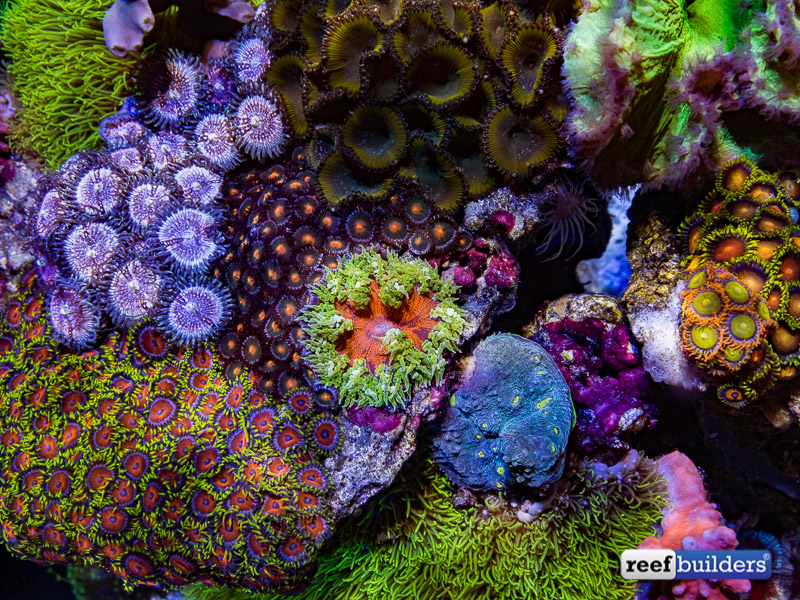By now we have all probably heard the quote from St. Bernard that the road to hell is paved with good intentions. That seems to be an especially appropriate quote for this hobby where it seems that often when we try to do something good for our tanks something bad results.
This is especially true where it comes to adding things to our tanks. As many of us have unfortunately found some of the things that we think are good or look good actually end up being bad or produce negative results after they have been added to our tanks. In many instances we have read up before we added them, but even the best laid plans sometimes fail.
To me what is interesting about this is that many of these organisms that now can be bad were thought of as good in the early days of the hobby. This is no doubt the result of how hardy these animals are. Back then our goal was simply not to kill them or to just keep them alive.
There was no thought of them really growing or taking off and smothering the other inhabitants of the tank, we were happy that they were hardy enough that it was difficult to kill them. So what are some of these organisms that we now add that may down the line cause problems or that we already added and are just starting to see the trouble they may cause.
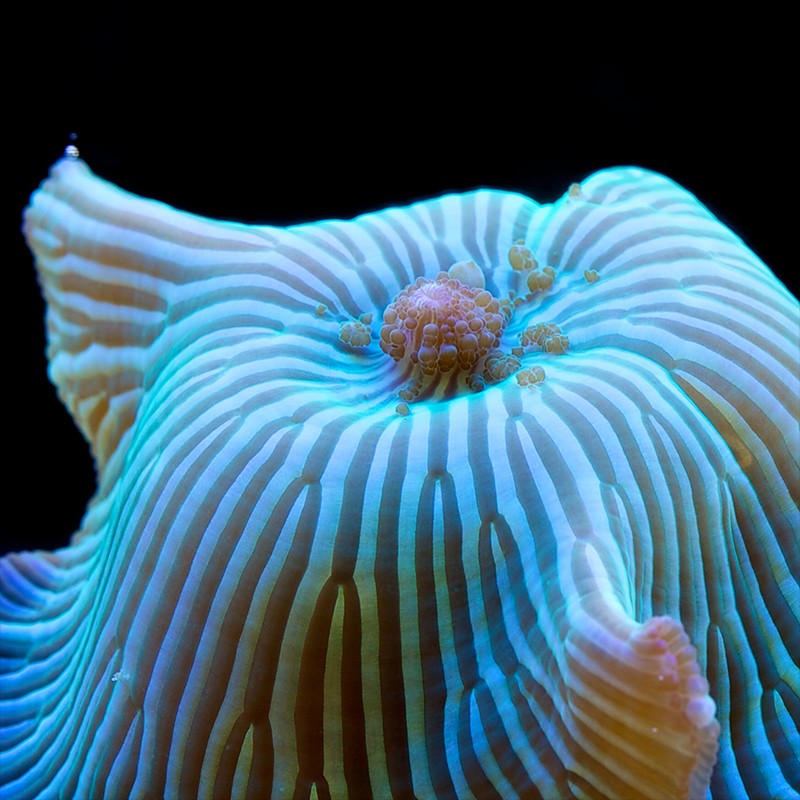
The first of these is one of the first “corals” that many of us tried and right now are actually the hottest thing in reefing. From those clues hopefully you figured out I am talking about mushroom anemones.
There are currently two schools right now in the world of mushroom anemones. There are those of us that have predominantly sps tanks where mushrooms pop up in the most inconvenient spots and burn the nearby corals and there are the people trying to propagate “bounce, eclectus and jawbreaker mushrooms as fast as possible owing to how tremendous the demand is for them right now.
Unfortunately, as with most things in this hobby the dull cheap pest mushrooms reproduce like rats while the high end in demand mushrooms do not. In my own tanks I have been battling a plague of a blue mushroom, they are actually attractive, that has a penchant for growing along the base of my sps colonies and irritating or burning them.
As a result, I have spent a significant amount of time scrubbing, peeling, poisoning and trying to get these pests away from my beloved sps, but they seemingly come from nothing and the more I try to remove them, the more they come back. And as I have heard from many of you, no mushroom rocks or rocks where any were even observed were ever added to the tank.
They seemingly did pop up from a “spore” on a piece of live rock. And considering that my “live rock” is over 15 years old they must have cropped up just from a piece of rock or plug that a coral was attached to. Sadly at least for me, none of the “hot” mushrooms that are all the rage, reproduce anywhere near as quickly or I could probably retire.

As with the mushrooms one of the most desired corals during the early days of the hobby was Xenia. While not brightly colored it was desired because it was the only coral that pulsed and it shipped poorly and often times the entire colony crashed for seemingly no reason.
As a result, it was often hard to come by and for those of us that had it, it was one of our most cherished corals. Now however times have changed in that now the water conditions in our tanks are far superior to the conditions back then and as a result most Xenia can now become a pest and overgrow a tank very quickly.
Most species produce a mucous or slime that irritates neighboring corals, especially sps corals so if not removed or controlled Xenia can very quickly dominate a tank. Also like Aiptasia, if only a small portion of the coral is left when it is being removed it will grow back and form a new colony so one needs to be meticulous when removing it.

I must admit that I have a warm spot for Xenia and have kept it for much of the time I have been in the hobby. Luckily I have found a thick-stalked variety that has all the positive attributes of Xenia and none of the bad traits. I bought this coral at a frag swap over 3 years ago and placed it in the center of my tank.
Over that span it has only grown into 4 heads on long stalks and it has never irritated or grown over any of the sps corals that grow all around it. I have just removed one of the heads and given it to Sanjay so it will be interesting to see if it responds the same in his tank, or owing to the higher nutrients, flow and light in his tank if it grows significantly faster and becomes a pest in any way.
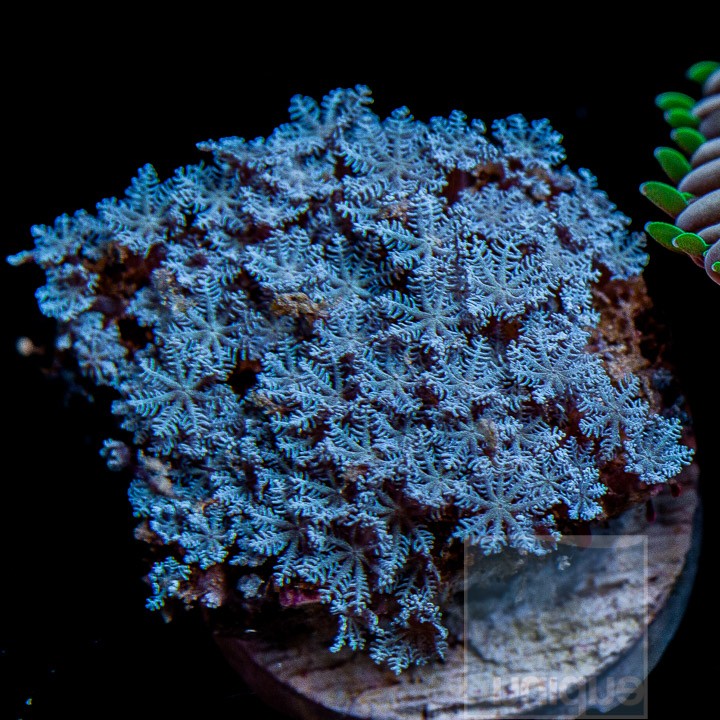
In addition to Xenia, another coral in its family, Anthelia, can also become a major pest. One type is very small with polyps little bigger than a pin head and it is blue or deep purple in color. This coral was sold a few years ago as a propagated piece and owing to its blue color it was quite popular.
However as I have unfortunately found out it quickly became a major pest and whenever it grows near sps corals it irritates them at the base so that many of them turn white and bleach. I once treated with an antibiotic that killed them, or at least I thought it killed all, but the antibiotic is also toxic to other soft corals and one it is used no soft corals like Xenia or leather corals can be added for at least 6 months afterward, so this treatment is not viable for my tank.
As a result, I have been brushing these pest corals off of the life rock every night for the past 3 months in an attempt to eventually eradicate them. I am now able to keep them in check but since I cannot get to every nook and cranny they still pop up throughout the tank and irritate whatever corals are near them.

Just as Xenia was one of the early stars of the hobby so too were star polyps. In the early days when very few colored corals existed the vivid bright green polyps of star polyps made them one of the most desired corals to have in our soft coral laden tanks.
As long as there was flow and nutrient levels were not too high so as to promote and algae bloom, these corals were the stars of many early tanks. Now since we are much better at managing nutrient levels and have consistent lighting, these corals like Xenia grow rapidly, so rapidly in fact that they seemingly overgrow neighboring sps corals overnight.
As a result, many owners of mixed tanks with both soft and stony corals often find themselves cutting these corals back or removing them completely lest they overgrow the entire tank. I have seen tanks where these corals were scraped from the rocks and removed, but where a few stray polyps blew off during the process and settled at the back of the tank. Then over time these corals eventually grew up the entire back glass and provided a green and purple backdrop for the entire tank.
Most of the star polyps that I have had problems with had a very thin base and were able to cover the nearby rocks and corals as a result of their growing so quickly. In my soft coral tank, I have a colony of star polyp unlike any I had seen previously in that its base is thick and its color is more of a light lavender rather than the plum purple of the fast growing types. In the year that I have kept it, it has only grown approximately an inch in each direction so that it may be a type of star polyp that can be kept long-term without it bothering nearby corals.
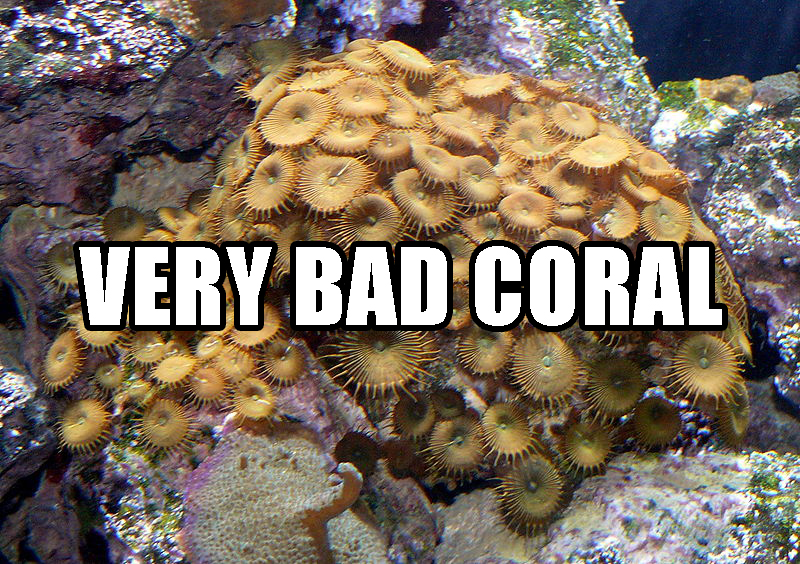
While everyone now knows that the above named corals can be problems and as a result most of us are not adding them to our collection like we used to, Palythoa corals are still being added regularly. These corals can be quite colorful and along with zooas under the right lighting they can be quite stunning. However, these additions can also be problematic like the above mentioned corals.
Also as has been well-documented in the past couple of years, when they are mishandled they can give of palytoxin, which is a highly toxic compound to fish, corals and especially humans. If they are left to their own device they will only be a pest to other corals in the tanks as over time they grow over, through and around their neighbors and eventually over grow them.
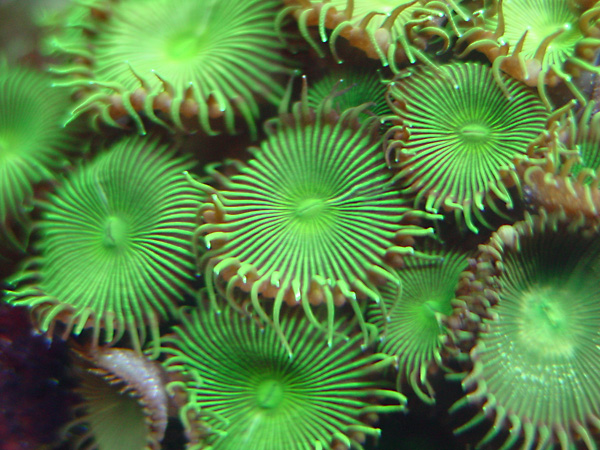
And while this is problematic like the above soft corals the real problem can arise when an attempt is made to remove them. In this case they secrete a mucous full of palytoxin that is toxic in miniscule amounts. If a hobbyist is unfortunate enough to get this into a wound or cut the results could be extremely serious and even possibly life-threatening.
Not knowing how toxic these animals were I along with 5 others tore down a tank containing them and simply took them out of the tank they were in on their rocks and placed them in holding tanks while we replaced the old tank with a new one.
We then proceeded to put all of the old corals, including several palythoa filled rocks and the fish back in the tank. The whole procedure took less than 3 hours. The next day all of the fish and corals in the tank were dead and 4 of the 6 of us were in the hospital with what we thought was a virulent flu.
The palythoa were never stressed and were not even ripped from the rock. They were simply moved through the air into the holding tanks and then back again. This was enough to get them to mucous up and release their toxin. Needless to say I do not keep any of them in any of my tanks as I do not want to relearn that lesson again. So if you do have them in your tank be extra cautious if you need to handle them and I can’t even tell you how to dispose of them in a completely safe manner.

While all of the above invertebrates can easily sneak into an aquarium on a piece of live rock and become problematic the next coral is one that we definitely add to our tanks intentionally. Sinularia have been a mainstay of the hobby since its inception. I never thought it could be a problem or invasive until I came across a tank where it was left to grow unchecked.
From a single colony on a piece of live rock it grew and overtook the tank completely in only 18 months. As the picture shows it came to completely dominate the tank and in doing so it crowded out or overgrew everything from star polyps to anemones.
To be honest once it had done so it looked the closest to a patch of reef that I have ever seen in a tank, but to the owner it was not very appealing. So needless to say if you maintain this type of coral once it starts to take off like this you need to trip it regularly to keep it in check.

Like Sinularia, most of the larger anemones are added to our tanks intentionally. For me at least there really is nothing quite as appealing in a tank as a pair of clownfish frolicking in an anemone. Unfortunately housing them with stony corals may come with a price.
I have now experienced first hand an anemone setting up in a location and then burning all of the stony corals around it. As a result I had to clear away a section of dead Montipora that the anemone stung that was approximately double the size of the anemone.
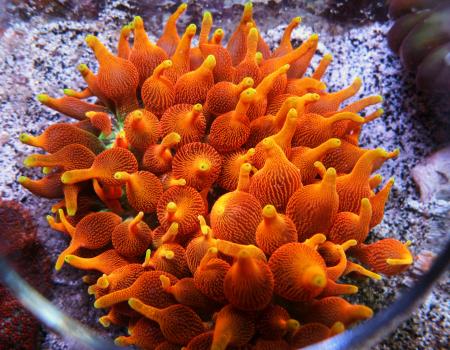
In addition, my anemones are now splitting with regularity and as a result they are taking up more and more real estate in my tank so now it is necessary to remove them when that is possible as the tend to be attached under the sturdiest pieces of live rock or in the worse case I have had to kill them via injecting them with kalkwasser.
We have come a long way in our husbandry as it was not too long ago that many of us had difficulty keeping them for any length of time. Now due to how good we have gotten at providing optimal conditions we now have these animals reproducing with regularity.
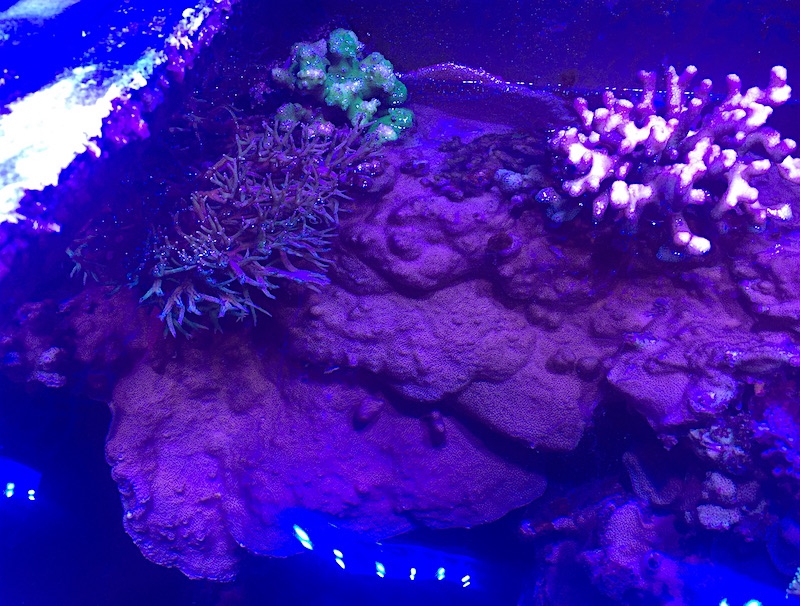
A similar situation is also now occurring with regularity with some of our stony corals. Some corals like the plating or whorling Montiporas are well now as causing problems when they grow too large and start overgrowing and shading the corals underneath them. In addition to that even some of the encrusting corals can become problematic over time.
Porites and encrusting Montiporas will overgrow their neighbors and if given the chance will even grow over equipment that gets in their way. The Porites in the picture grew from a frag that was less than an inch to a colony over 18 X 20inches in size and in doing so grew over several slower growing corals and grew down and shaded the entire area beneath it.
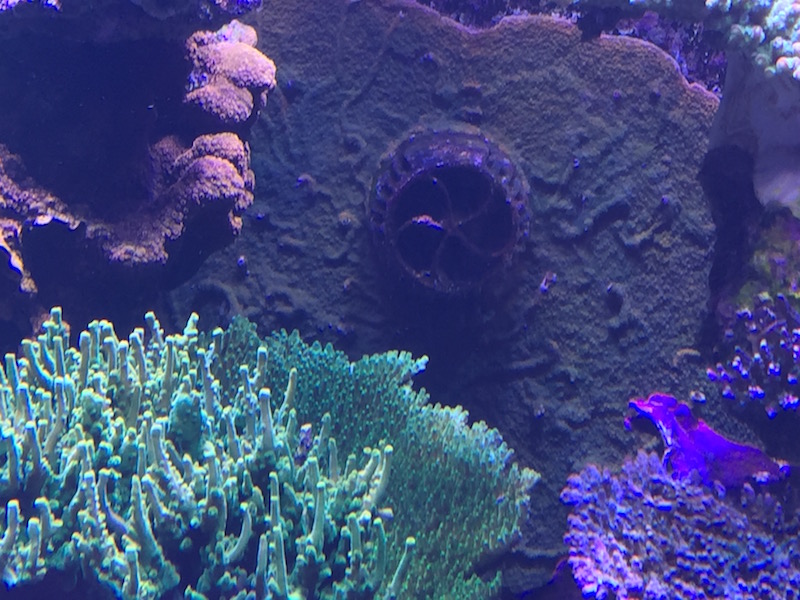
By the same token the Montipora in the picture grew from a frag that fell to the bottom of the tank. From there it grew up the back wall and started to overgrow the Vortech powerhead until it became necessary to remove the powerhead at regular intervals so that the wall could be scraped down and the powerhead replaced. If this was not done the Montipora would have overgrown the powerhead and rendered it useless.
While corals can become problematic over time as they grow and start to take over areas of our tanks fish in similar fashion often are added to our tanks with no problems and then they suddenly turn and become pests in their own right. We add angelfish knowing that at best it is a crapshoot as to whether they will bother the corals in our tanks.
And often they are good soldiers for a while and suddenly turn into pests for seemingly no reason. But we also add other fish that have stellar reputations and even these can turn into problems over time. I have observed a Desjardinii tang cause no problems for a couple of years suddenly become a master of hunting tuxedo urchins.
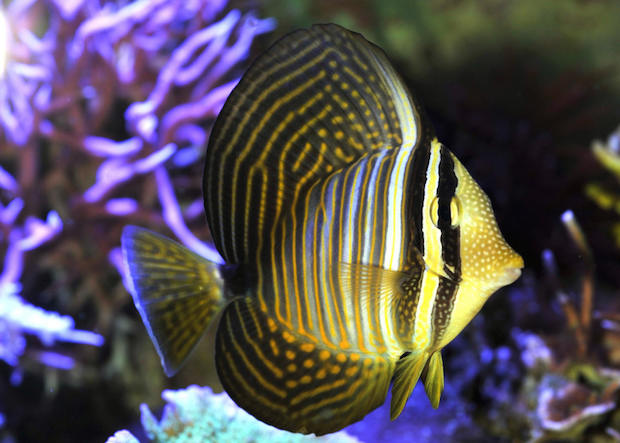
He would pick off the spines one by one until the urchin was defenseless and then like the well-known eater of urchins, the triggerfish, he would pick out the insides like a diner eating uni at a fine sushi restaurant. Then once he had finished off all of the urchins in the tank he moved on to the Tridacna clams, where he picked at their mantles until they eventually died from stress and then he devoured the flesh.
Once they were all gone he resorted back to not bothering the other inverts in the tank. This taught me the lesson that any fish, even one with little reputation for causing mayhem can be a problem under certain conditions. So this needs to be kept in mind any time fish are added.
We all have good intentions any time we add new corals or fish to our tanks. Most of the time what we add causes few problems. However, before adding anything we need to understand the possible problems that might result over time after the addition. Because we have gotten so good at this we need to understand what will happen as things grow, because they will.
Most of the time these problems are just corals battling corals, but as is the case with Palythoa, there can be problems to us as well, so this should be taken into account when we add corals like this or fish that may pose a threat to us should we need to remove them when they get large. The best way to keep these problems from happening is to not add some of these animals or to do our best to keep them small and keep them from getting out of control. But unfortunately we often do not see them as a problem until they have gotten out of control as we all love to see our animals grow and thrive.


